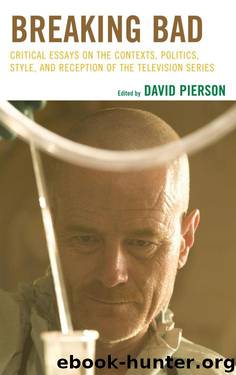Breaking Bad by Pierson David P

Author:Pierson, David P. [Pierson, David P.]
Language: eng
Format: epub
Publisher: Lexington Books
Published: 2012-03-07T23:00:00+00:00
III
The Style and Reception of Breaking Bad
Breaking Bad (AMC). Season 2 Episode 16: “4 Days Out.” Airdate: 3 May 2009. Shown: Aaron Paul, Bryan Cranston.
AMC/Photofest © AMC. Reprinted by permission of Photofest.
Chapter 7
BREAKING THE WAVES
Pierre Barrette and Yves Picard
Vince Gilligan (2011), the creator of Breaking Bad, during the Séries Mania festival in Paris in 2011 explained his work to a French audience clearly locating his series as belonging to the kind of recent American television fiction that draws on cinema rather than on television, or even in some cases on radio, for its aesthetic paradigm:
Chris Carter, the creator of The X-Files, his philosophy was that we are using moving pictures, we should therefore be telling a story visually, as visually as possible. That was, at the time, 1993, a bit, somewhat radical for an American television, the idea that showing rather than telling. In other words, a lot of television has been historically dialogue dependant, because series television has often not much time to shoot an episode and have to tell rather than show. But he was about showing rather than telling, whenever possible. And that is the philosophy I have very much taking heart, very much incorporated into the creation of Breaking Bad. (Gilligan, 2011)
Like the series Mad Men, which is also broadcast on the AMC network and which, as Jeremy Butler (2012) has demonstrated, has a visual aesthetic whose mise en scène references 1960s cinema more than it does television of the same period, Breaking Bad is part of a phenomenon that one scholar, following Variety, has described as the “cinematization of the small screen” (Buxton 1999, 69). That being the case, is the cinematization of American television fiction only a technological moment (the advent of high-definition television), or also a new degree of aesthetics? Breaking Bad provides an enlightening answer. Since the advent of the new millennium American television fiction, along with that found elsewhere, including Quebec (Picard 2011), has entered a “third Golden Age” (Perez-Gomez 2011), which we believe is also an age of second-degree style. This is what we set out to explain in the present text. In essence, we will argue that the television series created by Gilligan has attained a new degree of expression, one that Christian Metz (1991) described, following other scholars but in a distinct sense, as “enunciation,” or in a few words the meta-discursive expressive figures disseminated in the text. In the present discussion we will examine only a sampling of the series Breaking Bad’s second season. Beyond the wink, the reader will find here an invitation to compare our results with the other seasons, afterward examining the final season in particular, which was not yet completed at the time these lines were written. This text thus has a scholarly quality that Walter White would undoubtedly not have disdained at the outset of his quest: if the results of the experiment can be transferred, it is because the demonstration was conclusive.
To attain this end, we will proceed in three stages, according to a common scientific method: hypothesis, results and interpretation.
Download
This site does not store any files on its server. We only index and link to content provided by other sites. Please contact the content providers to delete copyright contents if any and email us, we'll remove relevant links or contents immediately.
| Direction & Production | Genres |
| Guides & Reviews | History & Criticism |
| Reference | Screenwriting |
| Shows |
Robin by Dave Itzkoff(2383)
Head of Drama by Sydney Newman(2255)
I'm Judging You by Luvvie Ajayi(2150)
The Paranormal 13 (13 free books featuring witches, vampires, werewolves, mermaids, psychics, Loki, time travel and more!) by unknow(2052)
Ten by Gretchen McNeil(1830)
Single State of Mind by Andi Dorfman(1759)
#MurderTrending by Gretchen McNeil(1613)
Key to the Sacred Pattern: The Untold Story of Rennes-le-Chateau by Henry Lincoln(1593)
Merv by Merv Griffin(1562)
Most Talkative by Andy Cohen(1546)
This Is Just My Face by Gabourey Sidibe(1432)
Notes from the Upside Down by Guy Adams(1411)
The Hunger Games: Official Illustrated Movie Companion by Egan Kate(1388)
Springfield Confidential by Mike Reiss(1362)
Jamie Oliver by Stafford Hildred(1356)
Binging with Babish by Andrew Rea(1329)
Clarkson--Look Who's Back by Gwen Russell(1305)
The TV Writer's Workbook: A Creative Approach To Television Scripts by Ellen Sandler(1299)
Blue Planet II by James Honeyborne & Mark Brownlow(1235)
